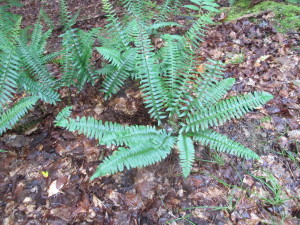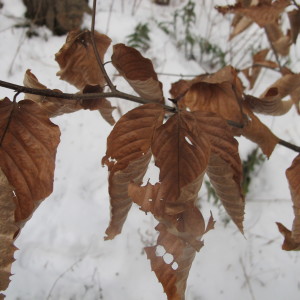Thoughts of Charles Darwin During a Walk in the Woods
I have great respect for Charles Darwin. He was a scientist who traveled around the world, observed nature, kept great records, collected specimens, applied logic and came up with a theory that changed how we see the world. He wrote The Origin of Species in 1859 which presented, clearly and forcefully, the theory which became known as evolution.
Darwin postulated that from time to time plants and animals had mutations that made them more or less competitive than others of their species. Those that were better able to survive had more progeny and their changes were more likely to persist and dominate. “Survival of the fittest” became a mantra of scientists that we’ve all heard.
On a recent walk in the woods I pondered Darwin’s ideas as I looked at the flora of the forest. At the forest floor I observed just one species of fern, the Christmas fern (Polystichum acrostichoides). It was everywhere I looked. Its greenery on that warm, sunny day presumably was using February sunshine to produce food for its roots. I know there are many other ferns in the woods, but all the others had lost their leaves in the fall, and were dormant. Using sunshine in winter must be an evolutionary advantage.
Next I reflected on the wildflowers I love. Early spring bloomers like hepatica are short and bloom before forest trees have leaves. Fall bloomers like goldenrod and cardinal flower are taller. Why is that? They may have evolved in competition with grasses and other tall plants that would shade out shorter things. Plants seem to time their blooming so that they will survive and thrive.
I have often wondered why young beech trees and some oaks hold onto their leaves until spring. Researching this on the web, I found a fabulous article in Northern Woodlands Magazine (http://northernwoodlands.org) by Vermont forester Michael Snyder. He explained that the first prehistoric trees were all evergreen, and that deciduous trees developed later. In cold regions such as ours, shedding leaves helps to minimize water loss and damage due to the cold.
The process of holding onto brown leaves until spring is called marcescence. Snyder postulated several reasons why this ability to hold onto leaves might be an advantage. First he noted that dropping leaves in spring might provide some organic matter as mulch just when a growing plant needs it. Leaves left on the ground all winter would be farther along in the decomposition process. In my view, that doesn’t make sense – trees that are growing green leaves need nitrogen, and brown leaves have little to offer. Nitrogen usually off-gasses when leaves turn brown, going back to the atmosphere. Sure, organic matter in the form of carbon does enrich the soil, but that is a slow process.
Snyder wrote that some other researchers suggest the leaves might help to trap snow in winter, thus retaining water. That does not match with my observations. Others suggested that the leaves might provide some protection to leaf buds against the cold. Again, that is not logical to me. Lastly, he proposes that the leaves might be a deterrent to hungry deer browsing tips of branches, removing leaf buds in winter. Yes, that makes a certain amount of sense to me.
Most trees are adapted to thrive either in sun or shade, but not both. The Canadian hemlock, one of the most common trees in my environment, can grow pretty much anywhere – full sun to full shade (though it does not do well in soggy soil). I can see why it so common in the wild. But it does not do well with road salt or pollution. Will this tree develop new varieties that are tolerant of human interference? Remember that evolution is very slow, often taking millions of years to create new species.
In marketing circles the promoters of a new product are always looking for a “market niche.” This means finding a product that no one else is selling, whether that be a wrist-watch computer or a new type of hair gel. It seems that plants do much the same. They “look for” a place where other plants don’t want to be or can’t succeed.
A great example of a plant market niche is on bare rocks. With no soil what self-respecting plant would want to grow there? Enter the lichens. These are relatively primitive living things that can survive on bare rock in full sun. Technically, they are not even plants.
Lichens are two life forms living together in a symbiotic relationship: fungus and algae or cyanobacteria. Those latter beings can, by photosynthesis, produce food; the fungus provides structure and moisture it gathers. Each species helps the other, and is helped by it. What an amazing evolutionary miracle! Together these living creatures have evolved the ability to live from Antarctica to tropical jungles. Lichens cover roughly 6% of our land mass – so I guess they’ve had good luck finding market niches.
So go for a walk and ponder the miracles of life. And try to figure out why beeches and oaks hold onto their leaves. If you come up with a new theory, be sure to let me know. I’m still not convinced I know the answer.
Henry is a UNH Lifetime Master Gardener and the author of 4 gardening books. His website is www.Gardening-Guy.com.




